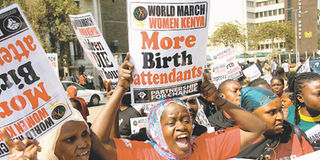Kenya races to reduce deaths at childbirth

Women held a demonstration to demand for more birth attendants in the city in August. The government is stepping up efforts to reduce maternal and infant mortality in the country. Photo/FILE
The Kenyan Government is stepping up efforts to reduce maternal mortality in the country.
The Ministry of Public Health and Sanitation recently launched the National Road Map Strategic Plan for this purpose. The country has already made some advances in cutting down infant mortality.
According to experts, there is urgent need to step up these efforts because maternal and child deaths are on the rise in most African countries.
And the fact that maternal health statistics in Kenya are not improving is cause for concern, given that only five years remain to the deadline for the achievement of the Millennium Development Goals (MDGs) — eight development targets adopted in 2001 by the world’s governments, which pledged to achieve them by 2015.
Kenya is hoping to attain MDGs 4 and 5, which aim to reduce child mortality and improve maternal health by 75 per cent.
In Kenya, 99 per cent of women attend ante-natal clinics at least once in their life. However, only 46 per cent of deliveries in the country are carried out by skilled attendants.
Even though these statistics paint a grim picture of access to maternal health care, the situation for women from impoverished backgrounds is even more serious.
“Poor women are seven times more likely to give birth at home than the rich, with little or no post-natal care,” said Public Health minister Beth Mugo during the launch of a maternal and child health project in Makindu District.
According to Ms Winfred Kaviti, the secretary of the community unit of Kamboo Dispensary in Makindu, provision of maternal healthcare services in the district has been a huge challenge.
Prior to the opening of the dispensary, Ms Kaviti says, new mothers were forced to travel as far as Symile Dispensary, 15 kilometres away or to the Makindu District Hospital.
Now the government plans to use community health workers as the link between healthcare institutions and the community.
Currently, maternal mortality stands at 578 per 100,000 live births, while infant mortality stands at 32 per 1,000 live births. Under five mortality stands at 54 per 1,000 live births.
The African Medical Research Foundation (Amref) and the European Union (EU) have pledged to assist the government reduce these unwarranted deaths.
Both Amref and the EU contributed Sh78 million towards the launch of the Makueni and Kitui Maternal and Child Health Project last
“Through this project, we anticipate to improve the health of 27,000 women of reproductive age and enable 25,000 children under the age of five to access better services,” said Ms Mette Kjaer, Amref country director.
According to the Planning ministry, Makueni and Kitui districts are among the poorest in the country, with 56 per cent of their population living in abject poverty.
The Public Health ministry estimates infant mortality to be 96 per 1,000 live births and maternal mortality to be 424 per 100,000 live births in the region.




